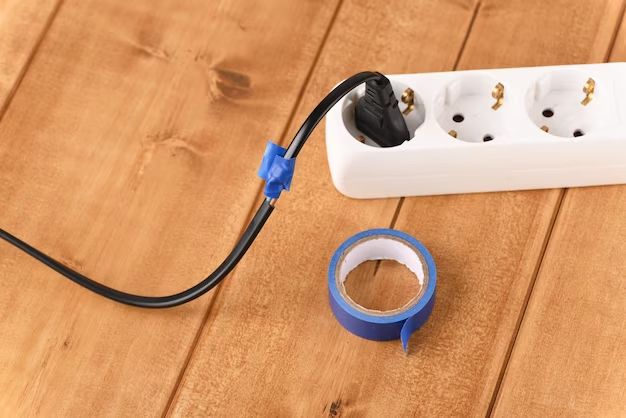Page Contents
What Causes Power Cords to Break?
Power cords can break for a variety of reasons. Some of the most common causes include:
- Pet damage – Pets like cats and dogs may chew on cords, fraying the protective rubber coating and exposing the internal wiring.
- Pinched or crushed cords – Heavy furniture can bend and pinch cords over time, breaking the internal wires.
- Pulling on the cord – Repeatedly yanking the cord out by the wire instead of the plug damages the connections.
- Age and wear – Power cords gradually become brittle and deteriorate with regular use over many years.
- Improper use – Twisting, kinking, or coiling the cord tightly leads to broken inner wires.
- Electrical surges – Power surges from lightning or faulty wiring can burn out cords.
- Rodents – Mice or rats may chew through the protective coating.
Knowing what typically causes power cords to fail can help you prevent damage in the future. Be especially cautious of pets, avoid pinching cords, don’t yank on the wire itself, and inspect cords periodically for wear.
Should You Repair or Replace a Broken Power Cord?
When faced with a broken power cord, you have two options – repair it or replace it. Here are some factors to consider when deciding between cord repair vs replacement:
- Safety – A damaged power cord poses a serious fire and shock hazard. It’s safest to just replace it.
- Cord condition – If the cord is very old and frayed, repair may not be worthwhile. Replacement is better.
- Location of break – Breaks near the plug are often repairable. Middle breaks can be tricky.
- Cost – Replacement cords are inexpensive. Repairs may cost nearly as much as a new cord.
In general, electrical safety experts recommend just replacing any broken power cord. But minor repairs can be done if the damage is located right by the plug and the cord is otherwise in good condition.
How to Repair a Broken Power Cord
If you need to repair a broken power cord, follow these steps:
- Unplug the cord from the outlet and device.
- Cut away any frayed or damaged areas, leaving enough cord to work with.
- Strip away about 1.5 inches of the outer rubber/plastic coating from the ends.
- Separate and trim the inner wires.
- Match up each colored wire to its corresponding terminal on the plug.
- twist the bare ends of each wire around the metal plug terminal.
- Attach the ground wire to the ground terminal.
- Carefully wrap each repair area with electrical tape for insulation.
- Plug the cord back into the device and outlet. Test for proper function.
Safety is paramount when repairing electrical cords. Be sure to shut off the circuit breaker for that outlet before starting. Use caution not to touch exposed wires or terminals. Only handle the rubber-coated sections of wires. Make sure no copper strands are sticking out from the connections.
How to Replace a Broken Power Cord
Replacing a defective or damaged power cord is quick and easy in most cases. Here are the steps:
- Unplug the appliance or device from the outlet.
- Examine where the cord connects to the device. There may be a removable panel or screw.
- Open the device access panel and disconnect the bad power cord.
- Take note of the prong type (2 or 3 prongs) and gauge of the original cord.
- Purchase an identical replacement cord from a hardware or electronics store.
- Connect the new power cord to the terminals in the device.
- Secure the cord with the original strain relief or grommet.
- Replace any access panels and screws.
- Plug in the device and test it for proper function.
Be sure to select a replacement cord with specifications that exactly match the original. The prong type, wire gauge, length, and insulation should all be identical for safety. Consult the device manual if you have any doubts. Electronics stores have a wide variety of replacement power cords.
Tips to Prevent Broken Power Cords
Here are some tips to keep your power cords from wearing out, cracking, and breaking:
- Coil cords loosely when storing, don’t wrap tightly.
- Use cable management clips and ties to prevent pinching.
- Keep cords away from high-traffic areas.
- Unplug cords by holding the plug, not the wire.
- Inspect cords for cracks and fraying monthly.
- Don’t staple or nail cords to walls or furniture.
- Ensure appliances cannot roll over cords.
- Don’t hide cords under rugs where they can be stepped on.
- Replace old cords every 5-7 years if frequently used.
- Train pets not to chew on electrical cords.
Following cord safety best practices will extend the life of your power cords and electrical appliances. Be proactive and replace any wires that are damaged or deteriorating before they can cause a dangerous short circuit. With proper care, your devices’ cords should last many years.
Conclusion
Damaged power cords are a serious electrical hazard, so replacement is usually the safest option. But if the cord is in overall good condition, repairing a break or cut near the plug is possible for someone with electrical knowledge. Be sure to match specifications exactly when swapping in a new power cord. And training pets, managing cords carefully, inspecting them routinely, and replacing old ones regularly will help avoid broken wires in the first place. Follow these tips and advice to keep your devices powered safely.
